Toxic Chemical Exposure: Sources, Pathways, and Health Impacts
VerifiedAdded on 2022/12/22
|11
|2640
|1
Report
AI Summary
This report provides a comprehensive overview of toxic chemical exposure, encompassing sources, pathways, and potential health impacts across various environments, including workplaces, homes, and the broader environment. The report delves into the different means by which individuals can be exposed to harmful substances, such as inhalation, ingestion, and skin contact, and highlights the role of the Environmental Protection Agency (EPA) in assessing these risks. It explores specific examples of toxic compounds found in workplaces and homes, detailing potential health effects ranging from respiratory issues to neurological damage and cancers. Furthermore, the report examines the vulnerability of various populations, including children and pregnant women, and offers recommendations for minimizing contamination in air, water, and soil. It emphasizes the importance of public awareness and proactive measures to improve ecological health and safeguard human well-being.
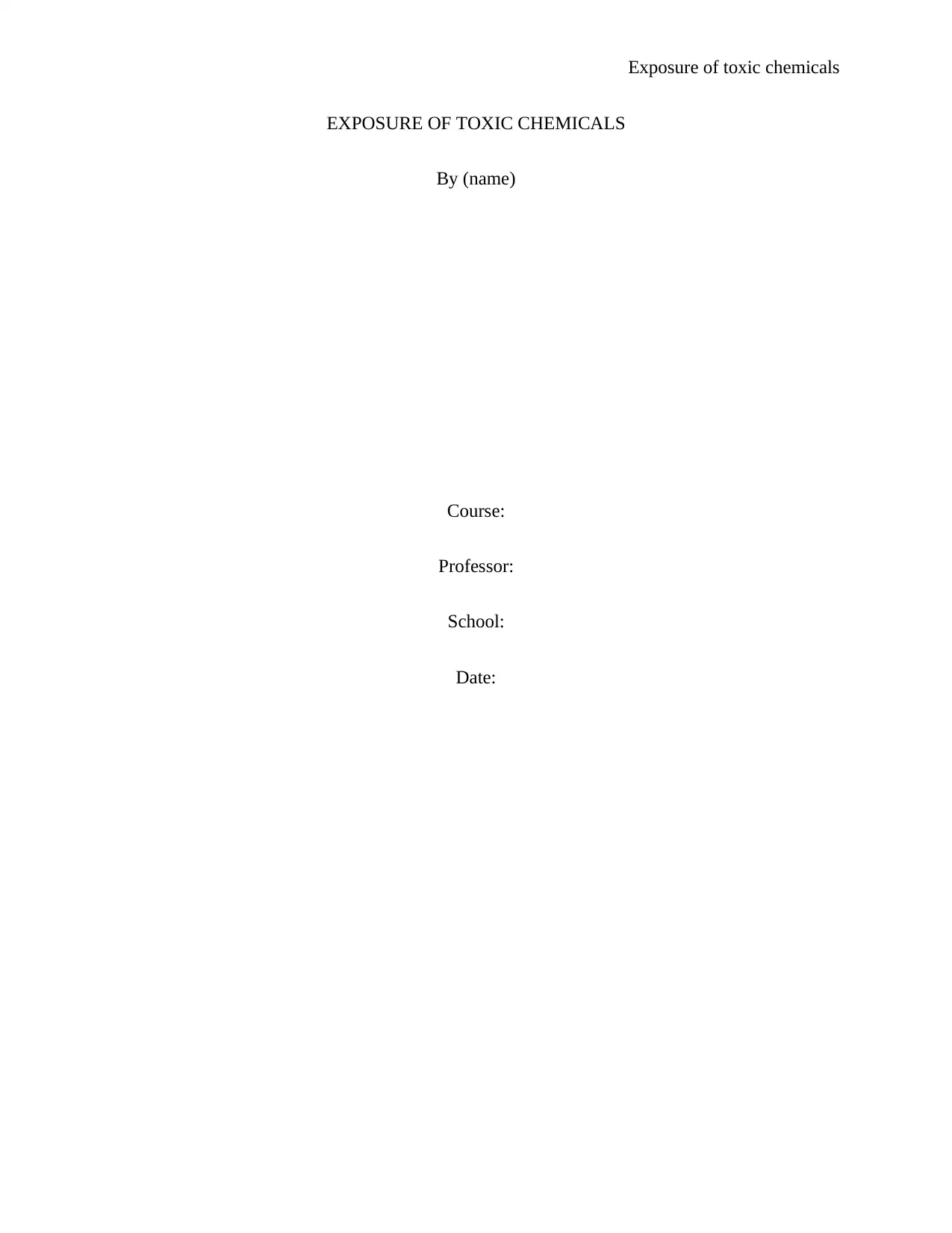
Exposure of toxic chemicals
EXPOSURE OF TOXIC CHEMICALS
By (name)
Course:
Professor:
School:
Date:
EXPOSURE OF TOXIC CHEMICALS
By (name)
Course:
Professor:
School:
Date:
Paraphrase This Document
Need a fresh take? Get an instant paraphrase of this document with our AI Paraphraser
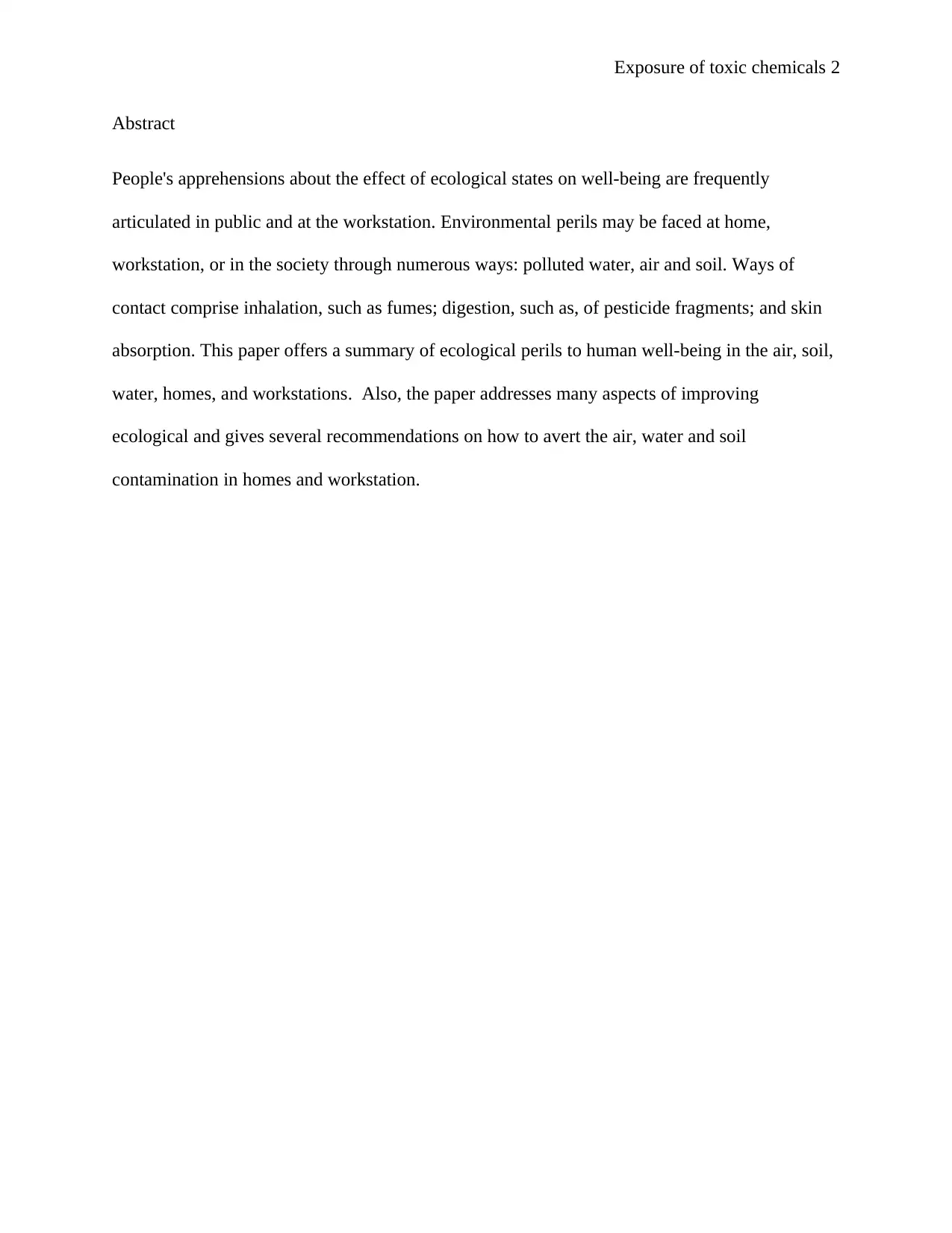
Exposure of toxic chemicals 2
Abstract
People's apprehensions about the effect of ecological states on well-being are frequently
articulated in public and at the workstation. Environmental perils may be faced at home,
workstation, or in the society through numerous ways: polluted water, air and soil. Ways of
contact comprise inhalation, such as fumes; digestion, such as, of pesticide fragments; and skin
absorption. This paper offers a summary of ecological perils to human well-being in the air, soil,
water, homes, and workstations. Also, the paper addresses many aspects of improving
ecological and gives several recommendations on how to avert the air, water and soil
contamination in homes and workstation.
Abstract
People's apprehensions about the effect of ecological states on well-being are frequently
articulated in public and at the workstation. Environmental perils may be faced at home,
workstation, or in the society through numerous ways: polluted water, air and soil. Ways of
contact comprise inhalation, such as fumes; digestion, such as, of pesticide fragments; and skin
absorption. This paper offers a summary of ecological perils to human well-being in the air, soil,
water, homes, and workstations. Also, the paper addresses many aspects of improving
ecological and gives several recommendations on how to avert the air, water and soil
contamination in homes and workstation.
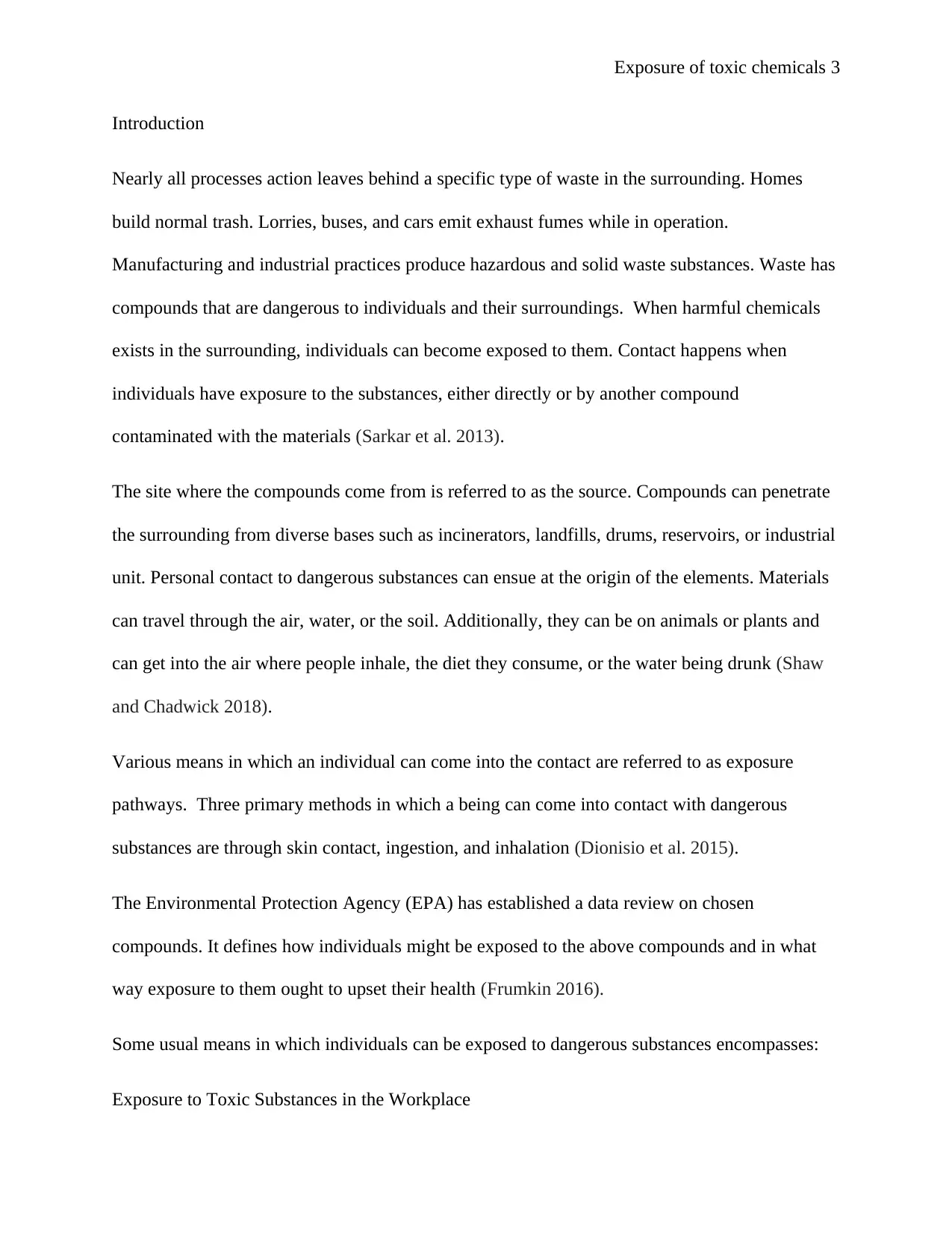
Exposure of toxic chemicals 3
Introduction
Nearly all processes action leaves behind a specific type of waste in the surrounding. Homes
build normal trash. Lorries, buses, and cars emit exhaust fumes while in operation.
Manufacturing and industrial practices produce hazardous and solid waste substances. Waste has
compounds that are dangerous to individuals and their surroundings. When harmful chemicals
exists in the surrounding, individuals can become exposed to them. Contact happens when
individuals have exposure to the substances, either directly or by another compound
contaminated with the materials (Sarkar et al. 2013).
The site where the compounds come from is referred to as the source. Compounds can penetrate
the surrounding from diverse bases such as incinerators, landfills, drums, reservoirs, or industrial
unit. Personal contact to dangerous substances can ensue at the origin of the elements. Materials
can travel through the air, water, or the soil. Additionally, they can be on animals or plants and
can get into the air where people inhale, the diet they consume, or the water being drunk (Shaw
and Chadwick 2018).
Various means in which an individual can come into the contact are referred to as exposure
pathways. Three primary methods in which a being can come into contact with dangerous
substances are through skin contact, ingestion, and inhalation (Dionisio et al. 2015).
The Environmental Protection Agency (EPA) has established a data review on chosen
compounds. It defines how individuals might be exposed to the above compounds and in what
way exposure to them ought to upset their health (Frumkin 2016).
Some usual means in which individuals can be exposed to dangerous substances encompasses:
Exposure to Toxic Substances in the Workplace
Introduction
Nearly all processes action leaves behind a specific type of waste in the surrounding. Homes
build normal trash. Lorries, buses, and cars emit exhaust fumes while in operation.
Manufacturing and industrial practices produce hazardous and solid waste substances. Waste has
compounds that are dangerous to individuals and their surroundings. When harmful chemicals
exists in the surrounding, individuals can become exposed to them. Contact happens when
individuals have exposure to the substances, either directly or by another compound
contaminated with the materials (Sarkar et al. 2013).
The site where the compounds come from is referred to as the source. Compounds can penetrate
the surrounding from diverse bases such as incinerators, landfills, drums, reservoirs, or industrial
unit. Personal contact to dangerous substances can ensue at the origin of the elements. Materials
can travel through the air, water, or the soil. Additionally, they can be on animals or plants and
can get into the air where people inhale, the diet they consume, or the water being drunk (Shaw
and Chadwick 2018).
Various means in which an individual can come into the contact are referred to as exposure
pathways. Three primary methods in which a being can come into contact with dangerous
substances are through skin contact, ingestion, and inhalation (Dionisio et al. 2015).
The Environmental Protection Agency (EPA) has established a data review on chosen
compounds. It defines how individuals might be exposed to the above compounds and in what
way exposure to them ought to upset their health (Frumkin 2016).
Some usual means in which individuals can be exposed to dangerous substances encompasses:
Exposure to Toxic Substances in the Workplace
⊘ This is a preview!⊘
Do you want full access?
Subscribe today to unlock all pages.

Trusted by 1+ million students worldwide
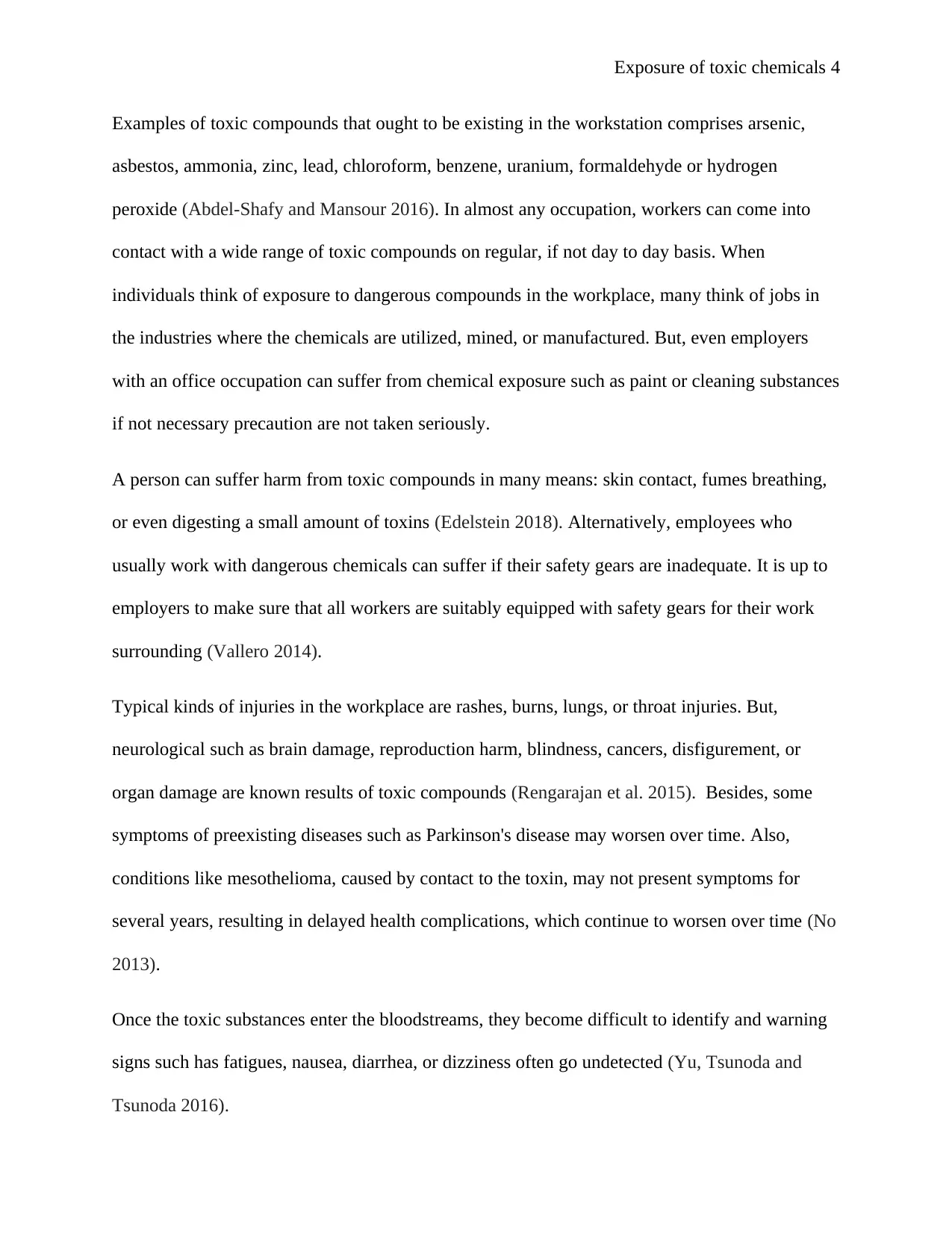
Exposure of toxic chemicals 4
Examples of toxic compounds that ought to be existing in the workstation comprises arsenic,
asbestos, ammonia, zinc, lead, chloroform, benzene, uranium, formaldehyde or hydrogen
peroxide (Abdel-Shafy and Mansour 2016). In almost any occupation, workers can come into
contact with a wide range of toxic compounds on regular, if not day to day basis. When
individuals think of exposure to dangerous compounds in the workplace, many think of jobs in
the industries where the chemicals are utilized, mined, or manufactured. But, even employers
with an office occupation can suffer from chemical exposure such as paint or cleaning substances
if not necessary precaution are not taken seriously.
A person can suffer harm from toxic compounds in many means: skin contact, fumes breathing,
or even digesting a small amount of toxins (Edelstein 2018). Alternatively, employees who
usually work with dangerous chemicals can suffer if their safety gears are inadequate. It is up to
employers to make sure that all workers are suitably equipped with safety gears for their work
surrounding (Vallero 2014).
Typical kinds of injuries in the workplace are rashes, burns, lungs, or throat injuries. But,
neurological such as brain damage, reproduction harm, blindness, cancers, disfigurement, or
organ damage are known results of toxic compounds (Rengarajan et al. 2015). Besides, some
symptoms of preexisting diseases such as Parkinson's disease may worsen over time. Also,
conditions like mesothelioma, caused by contact to the toxin, may not present symptoms for
several years, resulting in delayed health complications, which continue to worsen over time (No
2013).
Once the toxic substances enter the bloodstreams, they become difficult to identify and warning
signs such has fatigues, nausea, diarrhea, or dizziness often go undetected (Yu, Tsunoda and
Tsunoda 2016).
Examples of toxic compounds that ought to be existing in the workstation comprises arsenic,
asbestos, ammonia, zinc, lead, chloroform, benzene, uranium, formaldehyde or hydrogen
peroxide (Abdel-Shafy and Mansour 2016). In almost any occupation, workers can come into
contact with a wide range of toxic compounds on regular, if not day to day basis. When
individuals think of exposure to dangerous compounds in the workplace, many think of jobs in
the industries where the chemicals are utilized, mined, or manufactured. But, even employers
with an office occupation can suffer from chemical exposure such as paint or cleaning substances
if not necessary precaution are not taken seriously.
A person can suffer harm from toxic compounds in many means: skin contact, fumes breathing,
or even digesting a small amount of toxins (Edelstein 2018). Alternatively, employees who
usually work with dangerous chemicals can suffer if their safety gears are inadequate. It is up to
employers to make sure that all workers are suitably equipped with safety gears for their work
surrounding (Vallero 2014).
Typical kinds of injuries in the workplace are rashes, burns, lungs, or throat injuries. But,
neurological such as brain damage, reproduction harm, blindness, cancers, disfigurement, or
organ damage are known results of toxic compounds (Rengarajan et al. 2015). Besides, some
symptoms of preexisting diseases such as Parkinson's disease may worsen over time. Also,
conditions like mesothelioma, caused by contact to the toxin, may not present symptoms for
several years, resulting in delayed health complications, which continue to worsen over time (No
2013).
Once the toxic substances enter the bloodstreams, they become difficult to identify and warning
signs such has fatigues, nausea, diarrhea, or dizziness often go undetected (Yu, Tsunoda and
Tsunoda 2016).
Paraphrase This Document
Need a fresh take? Get an instant paraphrase of this document with our AI Paraphraser
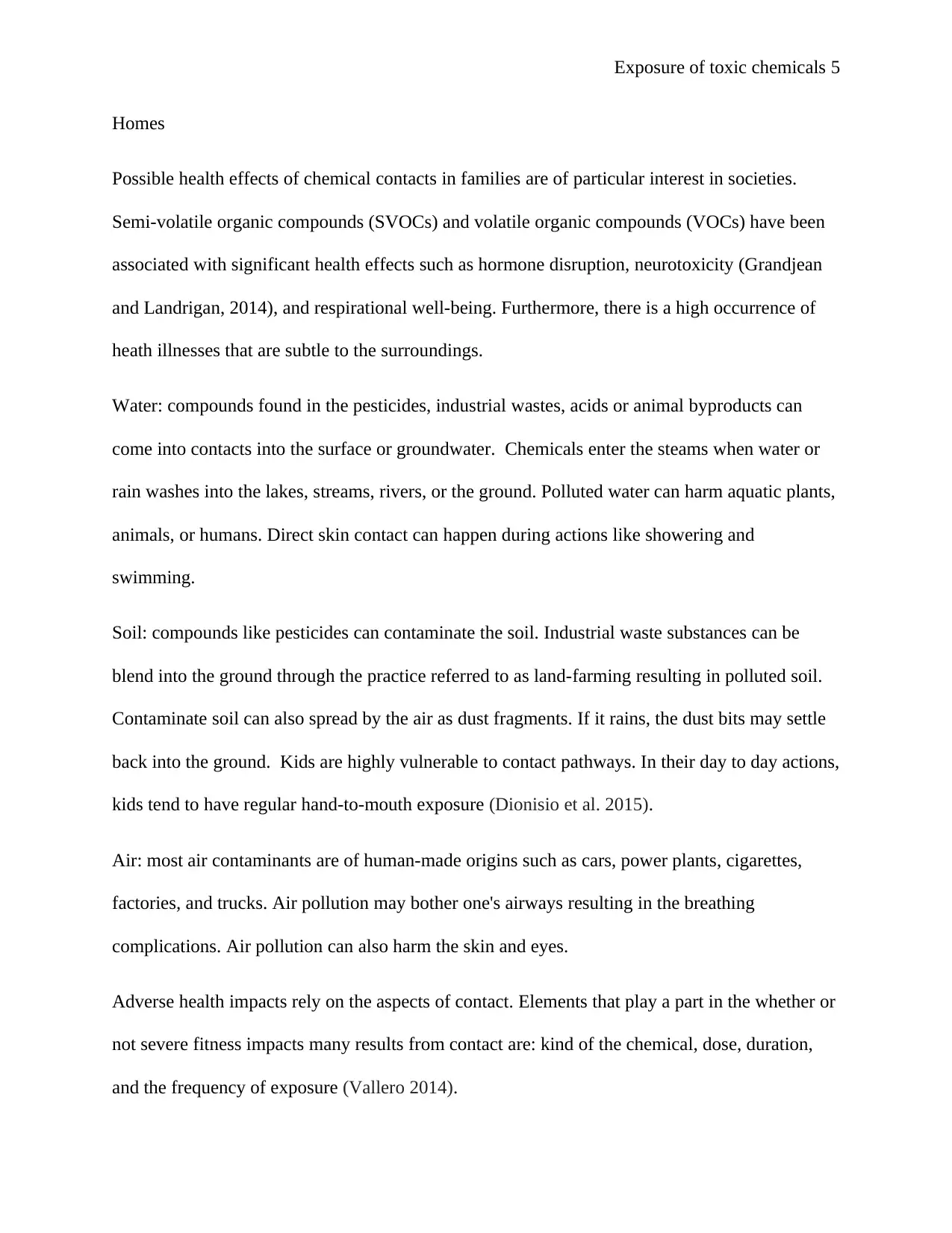
Exposure of toxic chemicals 5
Homes
Possible health effects of chemical contacts in families are of particular interest in societies.
Semi-volatile organic compounds (SVOCs) and volatile organic compounds (VOCs) have been
associated with significant health effects such as hormone disruption, neurotoxicity (Grandjean
and Landrigan, 2014), and respirational well-being. Furthermore, there is a high occurrence of
heath illnesses that are subtle to the surroundings.
Water: compounds found in the pesticides, industrial wastes, acids or animal byproducts can
come into contacts into the surface or groundwater. Chemicals enter the steams when water or
rain washes into the lakes, streams, rivers, or the ground. Polluted water can harm aquatic plants,
animals, or humans. Direct skin contact can happen during actions like showering and
swimming.
Soil: compounds like pesticides can contaminate the soil. Industrial waste substances can be
blend into the ground through the practice referred to as land-farming resulting in polluted soil.
Contaminate soil can also spread by the air as dust fragments. If it rains, the dust bits may settle
back into the ground. Kids are highly vulnerable to contact pathways. In their day to day actions,
kids tend to have regular hand-to-mouth exposure (Dionisio et al. 2015).
Air: most air contaminants are of human-made origins such as cars, power plants, cigarettes,
factories, and trucks. Air pollution may bother one's airways resulting in the breathing
complications. Air pollution can also harm the skin and eyes.
Adverse health impacts rely on the aspects of contact. Elements that play a part in the whether or
not severe fitness impacts many results from contact are: kind of the chemical, dose, duration,
and the frequency of exposure (Vallero 2014).
Homes
Possible health effects of chemical contacts in families are of particular interest in societies.
Semi-volatile organic compounds (SVOCs) and volatile organic compounds (VOCs) have been
associated with significant health effects such as hormone disruption, neurotoxicity (Grandjean
and Landrigan, 2014), and respirational well-being. Furthermore, there is a high occurrence of
heath illnesses that are subtle to the surroundings.
Water: compounds found in the pesticides, industrial wastes, acids or animal byproducts can
come into contacts into the surface or groundwater. Chemicals enter the steams when water or
rain washes into the lakes, streams, rivers, or the ground. Polluted water can harm aquatic plants,
animals, or humans. Direct skin contact can happen during actions like showering and
swimming.
Soil: compounds like pesticides can contaminate the soil. Industrial waste substances can be
blend into the ground through the practice referred to as land-farming resulting in polluted soil.
Contaminate soil can also spread by the air as dust fragments. If it rains, the dust bits may settle
back into the ground. Kids are highly vulnerable to contact pathways. In their day to day actions,
kids tend to have regular hand-to-mouth exposure (Dionisio et al. 2015).
Air: most air contaminants are of human-made origins such as cars, power plants, cigarettes,
factories, and trucks. Air pollution may bother one's airways resulting in the breathing
complications. Air pollution can also harm the skin and eyes.
Adverse health impacts rely on the aspects of contact. Elements that play a part in the whether or
not severe fitness impacts many results from contact are: kind of the chemical, dose, duration,
and the frequency of exposure (Vallero 2014).
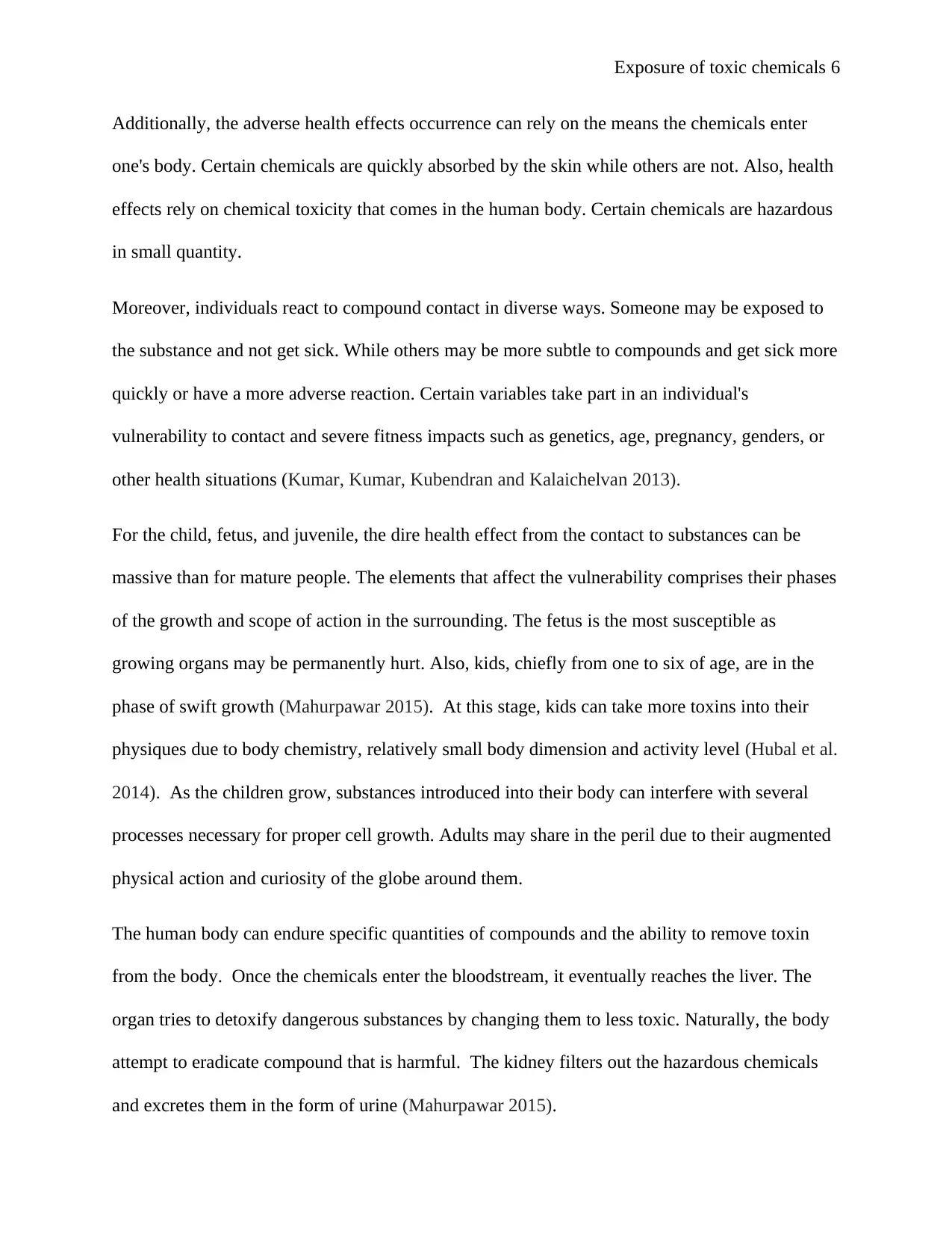
Exposure of toxic chemicals 6
Additionally, the adverse health effects occurrence can rely on the means the chemicals enter
one's body. Certain chemicals are quickly absorbed by the skin while others are not. Also, health
effects rely on chemical toxicity that comes in the human body. Certain chemicals are hazardous
in small quantity.
Moreover, individuals react to compound contact in diverse ways. Someone may be exposed to
the substance and not get sick. While others may be more subtle to compounds and get sick more
quickly or have a more adverse reaction. Certain variables take part in an individual's
vulnerability to contact and severe fitness impacts such as genetics, age, pregnancy, genders, or
other health situations (Kumar, Kumar, Kubendran and Kalaichelvan 2013).
For the child, fetus, and juvenile, the dire health effect from the contact to substances can be
massive than for mature people. The elements that affect the vulnerability comprises their phases
of the growth and scope of action in the surrounding. The fetus is the most susceptible as
growing organs may be permanently hurt. Also, kids, chiefly from one to six of age, are in the
phase of swift growth (Mahurpawar 2015). At this stage, kids can take more toxins into their
physiques due to body chemistry, relatively small body dimension and activity level (Hubal et al.
2014). As the children grow, substances introduced into their body can interfere with several
processes necessary for proper cell growth. Adults may share in the peril due to their augmented
physical action and curiosity of the globe around them.
The human body can endure specific quantities of compounds and the ability to remove toxin
from the body. Once the chemicals enter the bloodstream, it eventually reaches the liver. The
organ tries to detoxify dangerous substances by changing them to less toxic. Naturally, the body
attempt to eradicate compound that is harmful. The kidney filters out the hazardous chemicals
and excretes them in the form of urine (Mahurpawar 2015).
Additionally, the adverse health effects occurrence can rely on the means the chemicals enter
one's body. Certain chemicals are quickly absorbed by the skin while others are not. Also, health
effects rely on chemical toxicity that comes in the human body. Certain chemicals are hazardous
in small quantity.
Moreover, individuals react to compound contact in diverse ways. Someone may be exposed to
the substance and not get sick. While others may be more subtle to compounds and get sick more
quickly or have a more adverse reaction. Certain variables take part in an individual's
vulnerability to contact and severe fitness impacts such as genetics, age, pregnancy, genders, or
other health situations (Kumar, Kumar, Kubendran and Kalaichelvan 2013).
For the child, fetus, and juvenile, the dire health effect from the contact to substances can be
massive than for mature people. The elements that affect the vulnerability comprises their phases
of the growth and scope of action in the surrounding. The fetus is the most susceptible as
growing organs may be permanently hurt. Also, kids, chiefly from one to six of age, are in the
phase of swift growth (Mahurpawar 2015). At this stage, kids can take more toxins into their
physiques due to body chemistry, relatively small body dimension and activity level (Hubal et al.
2014). As the children grow, substances introduced into their body can interfere with several
processes necessary for proper cell growth. Adults may share in the peril due to their augmented
physical action and curiosity of the globe around them.
The human body can endure specific quantities of compounds and the ability to remove toxin
from the body. Once the chemicals enter the bloodstream, it eventually reaches the liver. The
organ tries to detoxify dangerous substances by changing them to less toxic. Naturally, the body
attempt to eradicate compound that is harmful. The kidney filters out the hazardous chemicals
and excretes them in the form of urine (Mahurpawar 2015).
⊘ This is a preview!⊘
Do you want full access?
Subscribe today to unlock all pages.

Trusted by 1+ million students worldwide
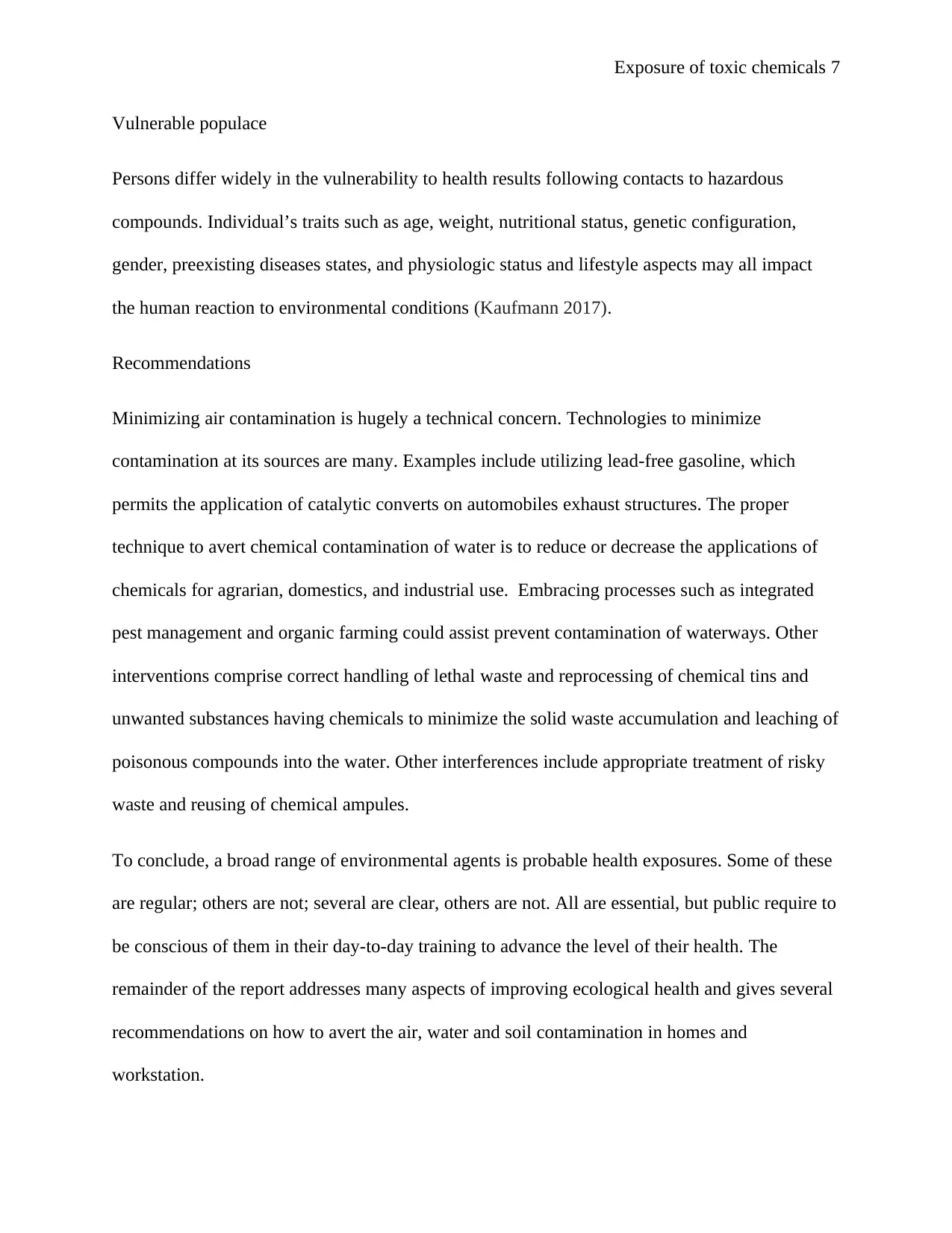
Exposure of toxic chemicals 7
Vulnerable populace
Persons differ widely in the vulnerability to health results following contacts to hazardous
compounds. Individual’s traits such as age, weight, nutritional status, genetic configuration,
gender, preexisting diseases states, and physiologic status and lifestyle aspects may all impact
the human reaction to environmental conditions (Kaufmann 2017).
Recommendations
Minimizing air contamination is hugely a technical concern. Technologies to minimize
contamination at its sources are many. Examples include utilizing lead-free gasoline, which
permits the application of catalytic converts on automobiles exhaust structures. The proper
technique to avert chemical contamination of water is to reduce or decrease the applications of
chemicals for agrarian, domestics, and industrial use. Embracing processes such as integrated
pest management and organic farming could assist prevent contamination of waterways. Other
interventions comprise correct handling of lethal waste and reprocessing of chemical tins and
unwanted substances having chemicals to minimize the solid waste accumulation and leaching of
poisonous compounds into the water. Other interferences include appropriate treatment of risky
waste and reusing of chemical ampules.
To conclude, a broad range of environmental agents is probable health exposures. Some of these
are regular; others are not; several are clear, others are not. All are essential, but public require to
be conscious of them in their day-to-day training to advance the level of their health. The
remainder of the report addresses many aspects of improving ecological health and gives several
recommendations on how to avert the air, water and soil contamination in homes and
workstation.
Vulnerable populace
Persons differ widely in the vulnerability to health results following contacts to hazardous
compounds. Individual’s traits such as age, weight, nutritional status, genetic configuration,
gender, preexisting diseases states, and physiologic status and lifestyle aspects may all impact
the human reaction to environmental conditions (Kaufmann 2017).
Recommendations
Minimizing air contamination is hugely a technical concern. Technologies to minimize
contamination at its sources are many. Examples include utilizing lead-free gasoline, which
permits the application of catalytic converts on automobiles exhaust structures. The proper
technique to avert chemical contamination of water is to reduce or decrease the applications of
chemicals for agrarian, domestics, and industrial use. Embracing processes such as integrated
pest management and organic farming could assist prevent contamination of waterways. Other
interventions comprise correct handling of lethal waste and reprocessing of chemical tins and
unwanted substances having chemicals to minimize the solid waste accumulation and leaching of
poisonous compounds into the water. Other interferences include appropriate treatment of risky
waste and reusing of chemical ampules.
To conclude, a broad range of environmental agents is probable health exposures. Some of these
are regular; others are not; several are clear, others are not. All are essential, but public require to
be conscious of them in their day-to-day training to advance the level of their health. The
remainder of the report addresses many aspects of improving ecological health and gives several
recommendations on how to avert the air, water and soil contamination in homes and
workstation.
Paraphrase This Document
Need a fresh take? Get an instant paraphrase of this document with our AI Paraphraser
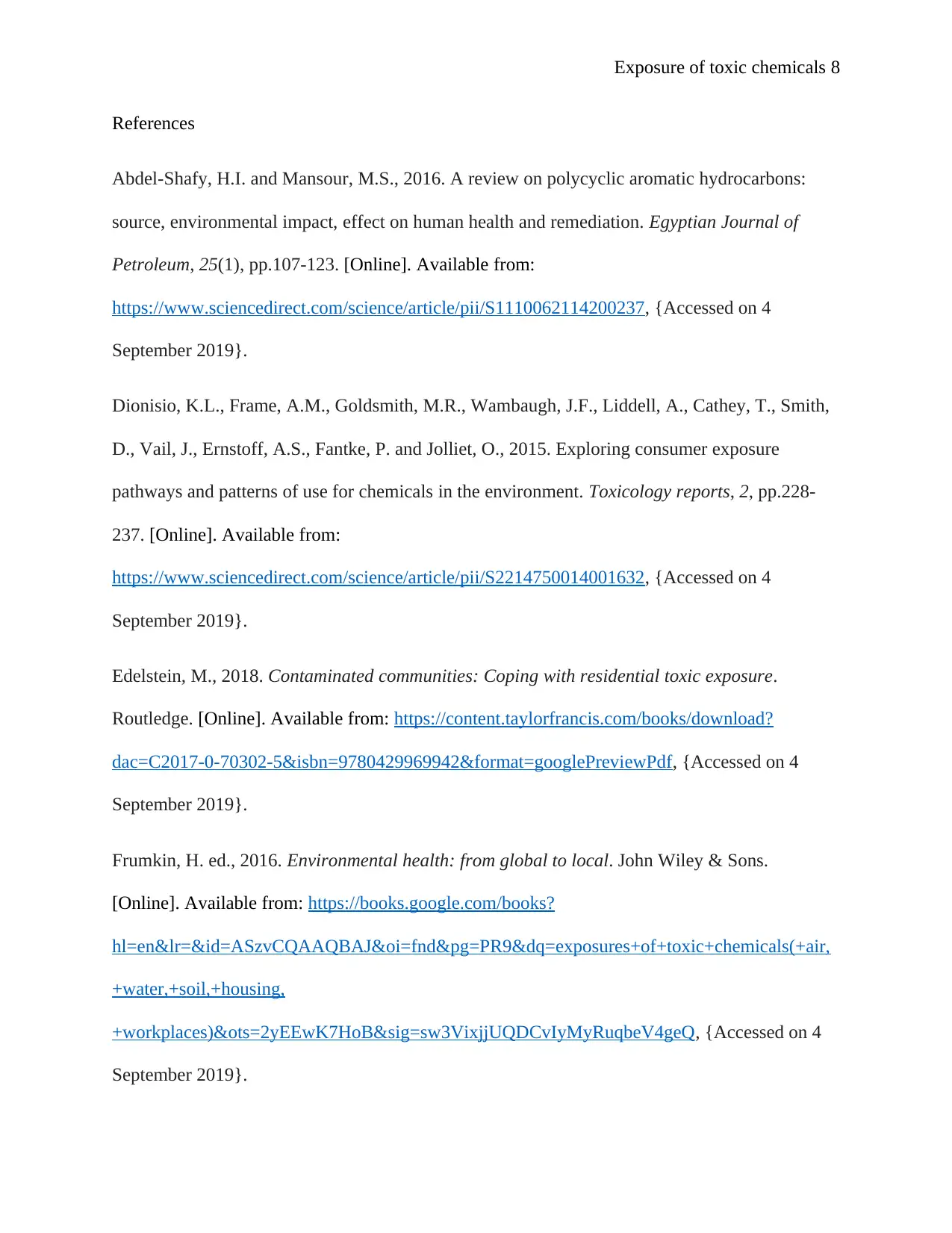
Exposure of toxic chemicals 8
References
Abdel-Shafy, H.I. and Mansour, M.S., 2016. A review on polycyclic aromatic hydrocarbons:
source, environmental impact, effect on human health and remediation. Egyptian Journal of
Petroleum, 25(1), pp.107-123. [Online]. Available from:
https://www.sciencedirect.com/science/article/pii/S1110062114200237, {Accessed on 4
September 2019}.
Dionisio, K.L., Frame, A.M., Goldsmith, M.R., Wambaugh, J.F., Liddell, A., Cathey, T., Smith,
D., Vail, J., Ernstoff, A.S., Fantke, P. and Jolliet, O., 2015. Exploring consumer exposure
pathways and patterns of use for chemicals in the environment. Toxicology reports, 2, pp.228-
237. [Online]. Available from:
https://www.sciencedirect.com/science/article/pii/S2214750014001632, {Accessed on 4
September 2019}.
Edelstein, M., 2018. Contaminated communities: Coping with residential toxic exposure.
Routledge. [Online]. Available from: https://content.taylorfrancis.com/books/download?
dac=C2017-0-70302-5&isbn=9780429969942&format=googlePreviewPdf, {Accessed on 4
September 2019}.
Frumkin, H. ed., 2016. Environmental health: from global to local. John Wiley & Sons.
[Online]. Available from: https://books.google.com/books?
hl=en&lr=&id=ASzvCQAAQBAJ&oi=fnd&pg=PR9&dq=exposures+of+toxic+chemicals(+air,
+water,+soil,+housing,
+workplaces)&ots=2yEEwK7HoB&sig=sw3VixjjUQDCvIyMyRuqbeV4geQ, {Accessed on 4
September 2019}.
References
Abdel-Shafy, H.I. and Mansour, M.S., 2016. A review on polycyclic aromatic hydrocarbons:
source, environmental impact, effect on human health and remediation. Egyptian Journal of
Petroleum, 25(1), pp.107-123. [Online]. Available from:
https://www.sciencedirect.com/science/article/pii/S1110062114200237, {Accessed on 4
September 2019}.
Dionisio, K.L., Frame, A.M., Goldsmith, M.R., Wambaugh, J.F., Liddell, A., Cathey, T., Smith,
D., Vail, J., Ernstoff, A.S., Fantke, P. and Jolliet, O., 2015. Exploring consumer exposure
pathways and patterns of use for chemicals in the environment. Toxicology reports, 2, pp.228-
237. [Online]. Available from:
https://www.sciencedirect.com/science/article/pii/S2214750014001632, {Accessed on 4
September 2019}.
Edelstein, M., 2018. Contaminated communities: Coping with residential toxic exposure.
Routledge. [Online]. Available from: https://content.taylorfrancis.com/books/download?
dac=C2017-0-70302-5&isbn=9780429969942&format=googlePreviewPdf, {Accessed on 4
September 2019}.
Frumkin, H. ed., 2016. Environmental health: from global to local. John Wiley & Sons.
[Online]. Available from: https://books.google.com/books?
hl=en&lr=&id=ASzvCQAAQBAJ&oi=fnd&pg=PR9&dq=exposures+of+toxic+chemicals(+air,
+water,+soil,+housing,
+workplaces)&ots=2yEEwK7HoB&sig=sw3VixjjUQDCvIyMyRuqbeV4geQ, {Accessed on 4
September 2019}.
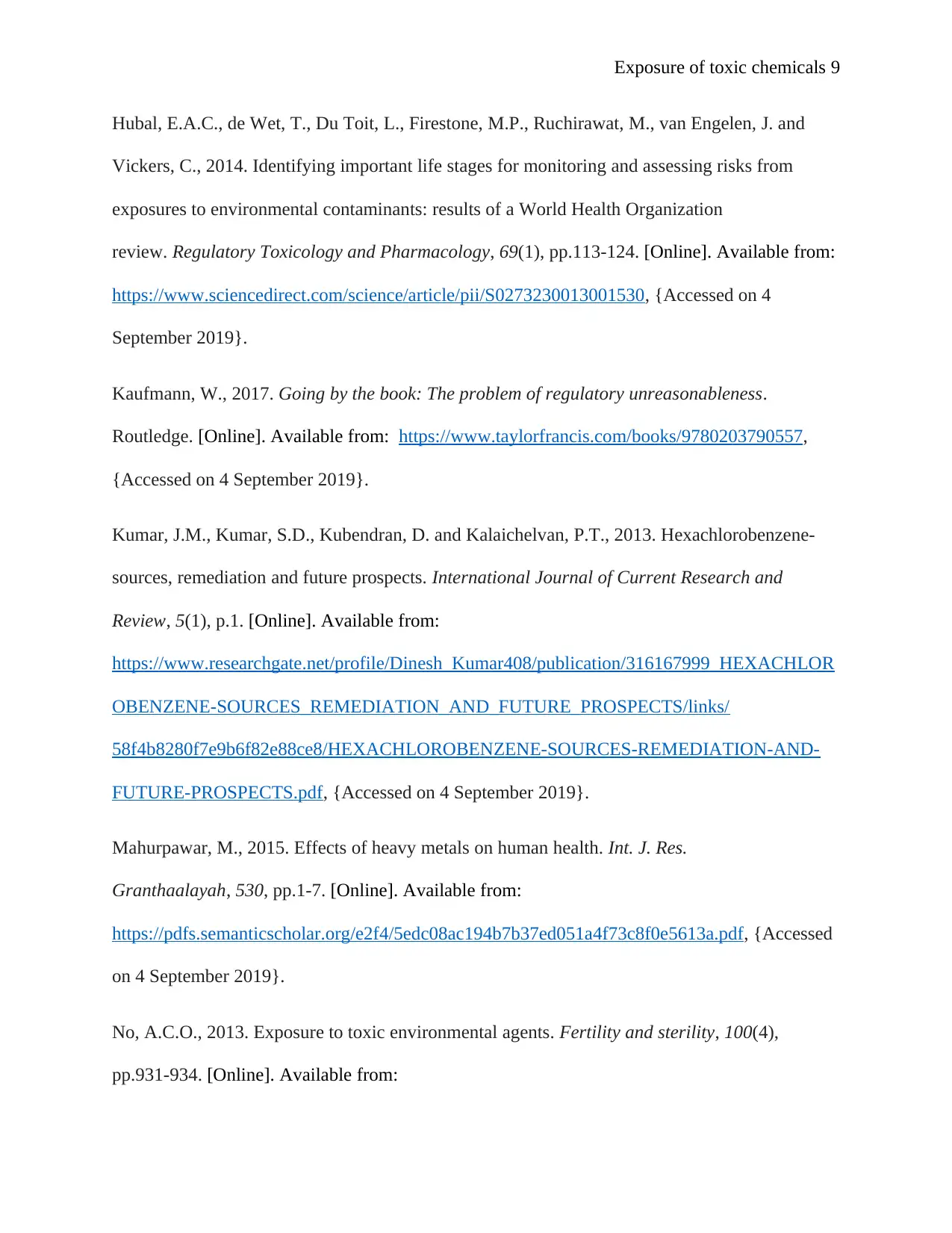
Exposure of toxic chemicals 9
Hubal, E.A.C., de Wet, T., Du Toit, L., Firestone, M.P., Ruchirawat, M., van Engelen, J. and
Vickers, C., 2014. Identifying important life stages for monitoring and assessing risks from
exposures to environmental contaminants: results of a World Health Organization
review. Regulatory Toxicology and Pharmacology, 69(1), pp.113-124. [Online]. Available from:
https://www.sciencedirect.com/science/article/pii/S0273230013001530, {Accessed on 4
September 2019}.
Kaufmann, W., 2017. Going by the book: The problem of regulatory unreasonableness.
Routledge. [Online]. Available from: https://www.taylorfrancis.com/books/9780203790557,
{Accessed on 4 September 2019}.
Kumar, J.M., Kumar, S.D., Kubendran, D. and Kalaichelvan, P.T., 2013. Hexachlorobenzene-
sources, remediation and future prospects. International Journal of Current Research and
Review, 5(1), p.1. [Online]. Available from:
https://www.researchgate.net/profile/Dinesh_Kumar408/publication/316167999_HEXACHLOR
OBENZENE-SOURCES_REMEDIATION_AND_FUTURE_PROSPECTS/links/
58f4b8280f7e9b6f82e88ce8/HEXACHLOROBENZENE-SOURCES-REMEDIATION-AND-
FUTURE-PROSPECTS.pdf, {Accessed on 4 September 2019}.
Mahurpawar, M., 2015. Effects of heavy metals on human health. Int. J. Res.
Granthaalayah, 530, pp.1-7. [Online]. Available from:
https://pdfs.semanticscholar.org/e2f4/5edc08ac194b7b37ed051a4f73c8f0e5613a.pdf, {Accessed
on 4 September 2019}.
No, A.C.O., 2013. Exposure to toxic environmental agents. Fertility and sterility, 100(4),
pp.931-934. [Online]. Available from:
Hubal, E.A.C., de Wet, T., Du Toit, L., Firestone, M.P., Ruchirawat, M., van Engelen, J. and
Vickers, C., 2014. Identifying important life stages for monitoring and assessing risks from
exposures to environmental contaminants: results of a World Health Organization
review. Regulatory Toxicology and Pharmacology, 69(1), pp.113-124. [Online]. Available from:
https://www.sciencedirect.com/science/article/pii/S0273230013001530, {Accessed on 4
September 2019}.
Kaufmann, W., 2017. Going by the book: The problem of regulatory unreasonableness.
Routledge. [Online]. Available from: https://www.taylorfrancis.com/books/9780203790557,
{Accessed on 4 September 2019}.
Kumar, J.M., Kumar, S.D., Kubendran, D. and Kalaichelvan, P.T., 2013. Hexachlorobenzene-
sources, remediation and future prospects. International Journal of Current Research and
Review, 5(1), p.1. [Online]. Available from:
https://www.researchgate.net/profile/Dinesh_Kumar408/publication/316167999_HEXACHLOR
OBENZENE-SOURCES_REMEDIATION_AND_FUTURE_PROSPECTS/links/
58f4b8280f7e9b6f82e88ce8/HEXACHLOROBENZENE-SOURCES-REMEDIATION-AND-
FUTURE-PROSPECTS.pdf, {Accessed on 4 September 2019}.
Mahurpawar, M., 2015. Effects of heavy metals on human health. Int. J. Res.
Granthaalayah, 530, pp.1-7. [Online]. Available from:
https://pdfs.semanticscholar.org/e2f4/5edc08ac194b7b37ed051a4f73c8f0e5613a.pdf, {Accessed
on 4 September 2019}.
No, A.C.O., 2013. Exposure to toxic environmental agents. Fertility and sterility, 100(4),
pp.931-934. [Online]. Available from:
⊘ This is a preview!⊘
Do you want full access?
Subscribe today to unlock all pages.

Trusted by 1+ million students worldwide
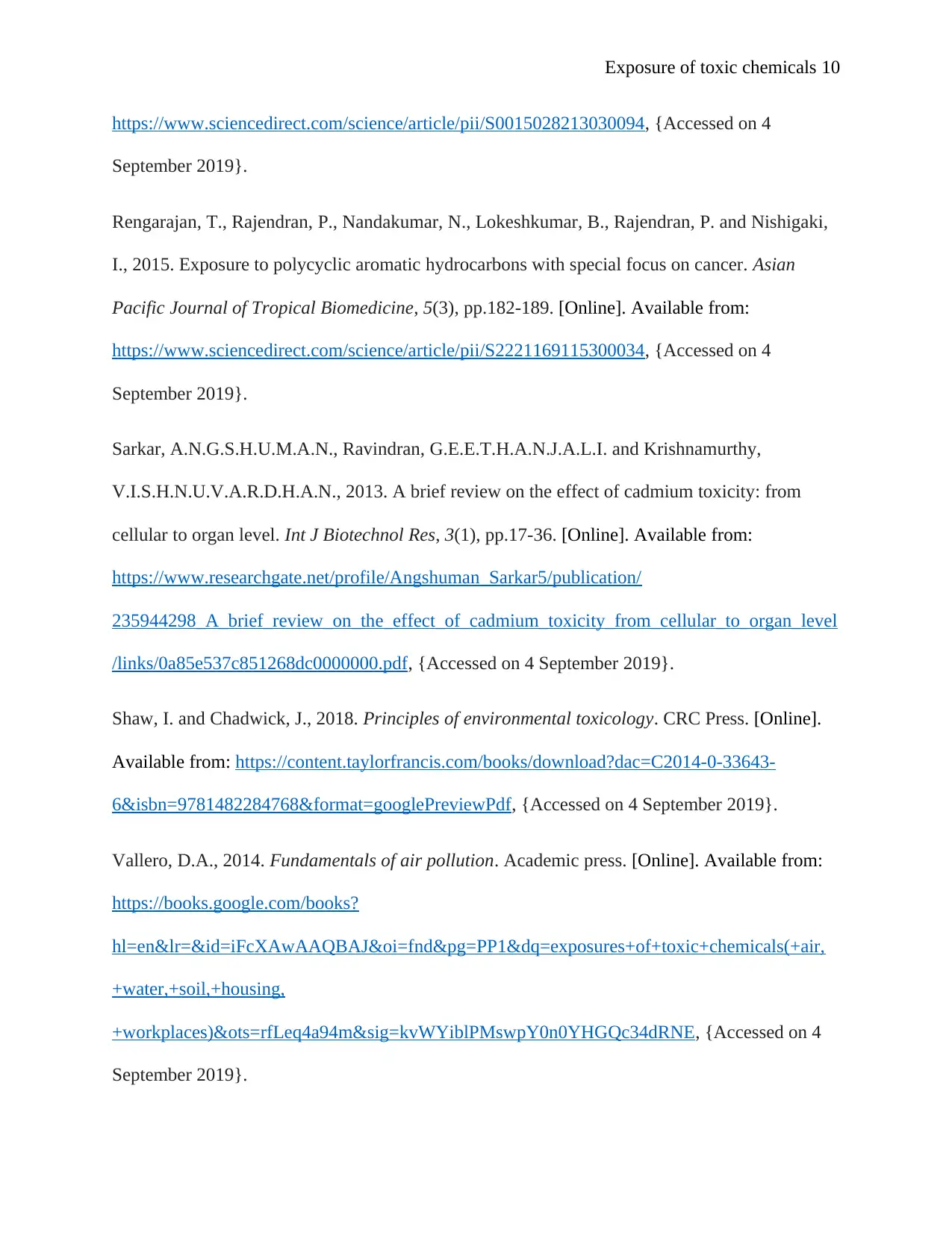
Exposure of toxic chemicals 10
https://www.sciencedirect.com/science/article/pii/S0015028213030094, {Accessed on 4
September 2019}.
Rengarajan, T., Rajendran, P., Nandakumar, N., Lokeshkumar, B., Rajendran, P. and Nishigaki,
I., 2015. Exposure to polycyclic aromatic hydrocarbons with special focus on cancer. Asian
Pacific Journal of Tropical Biomedicine, 5(3), pp.182-189. [Online]. Available from:
https://www.sciencedirect.com/science/article/pii/S2221169115300034, {Accessed on 4
September 2019}.
Sarkar, A.N.G.S.H.U.M.A.N., Ravindran, G.E.E.T.H.A.N.J.A.L.I. and Krishnamurthy,
V.I.S.H.N.U.V.A.R.D.H.A.N., 2013. A brief review on the effect of cadmium toxicity: from
cellular to organ level. Int J Biotechnol Res, 3(1), pp.17-36. [Online]. Available from:
https://www.researchgate.net/profile/Angshuman_Sarkar5/publication/
235944298_A_brief_review_on_the_effect_of_cadmium_toxicity_from_cellular_to_organ_level
/links/0a85e537c851268dc0000000.pdf, {Accessed on 4 September 2019}.
Shaw, I. and Chadwick, J., 2018. Principles of environmental toxicology. CRC Press. [Online].
Available from: https://content.taylorfrancis.com/books/download?dac=C2014-0-33643-
6&isbn=9781482284768&format=googlePreviewPdf, {Accessed on 4 September 2019}.
Vallero, D.A., 2014. Fundamentals of air pollution. Academic press. [Online]. Available from:
https://books.google.com/books?
hl=en&lr=&id=iFcXAwAAQBAJ&oi=fnd&pg=PP1&dq=exposures+of+toxic+chemicals(+air,
+water,+soil,+housing,
+workplaces)&ots=rfLeq4a94m&sig=kvWYiblPMswpY0n0YHGQc34dRNE, {Accessed on 4
September 2019}.
https://www.sciencedirect.com/science/article/pii/S0015028213030094, {Accessed on 4
September 2019}.
Rengarajan, T., Rajendran, P., Nandakumar, N., Lokeshkumar, B., Rajendran, P. and Nishigaki,
I., 2015. Exposure to polycyclic aromatic hydrocarbons with special focus on cancer. Asian
Pacific Journal of Tropical Biomedicine, 5(3), pp.182-189. [Online]. Available from:
https://www.sciencedirect.com/science/article/pii/S2221169115300034, {Accessed on 4
September 2019}.
Sarkar, A.N.G.S.H.U.M.A.N., Ravindran, G.E.E.T.H.A.N.J.A.L.I. and Krishnamurthy,
V.I.S.H.N.U.V.A.R.D.H.A.N., 2013. A brief review on the effect of cadmium toxicity: from
cellular to organ level. Int J Biotechnol Res, 3(1), pp.17-36. [Online]. Available from:
https://www.researchgate.net/profile/Angshuman_Sarkar5/publication/
235944298_A_brief_review_on_the_effect_of_cadmium_toxicity_from_cellular_to_organ_level
/links/0a85e537c851268dc0000000.pdf, {Accessed on 4 September 2019}.
Shaw, I. and Chadwick, J., 2018. Principles of environmental toxicology. CRC Press. [Online].
Available from: https://content.taylorfrancis.com/books/download?dac=C2014-0-33643-
6&isbn=9781482284768&format=googlePreviewPdf, {Accessed on 4 September 2019}.
Vallero, D.A., 2014. Fundamentals of air pollution. Academic press. [Online]. Available from:
https://books.google.com/books?
hl=en&lr=&id=iFcXAwAAQBAJ&oi=fnd&pg=PP1&dq=exposures+of+toxic+chemicals(+air,
+water,+soil,+housing,
+workplaces)&ots=rfLeq4a94m&sig=kvWYiblPMswpY0n0YHGQc34dRNE, {Accessed on 4
September 2019}.
Paraphrase This Document
Need a fresh take? Get an instant paraphrase of this document with our AI Paraphraser
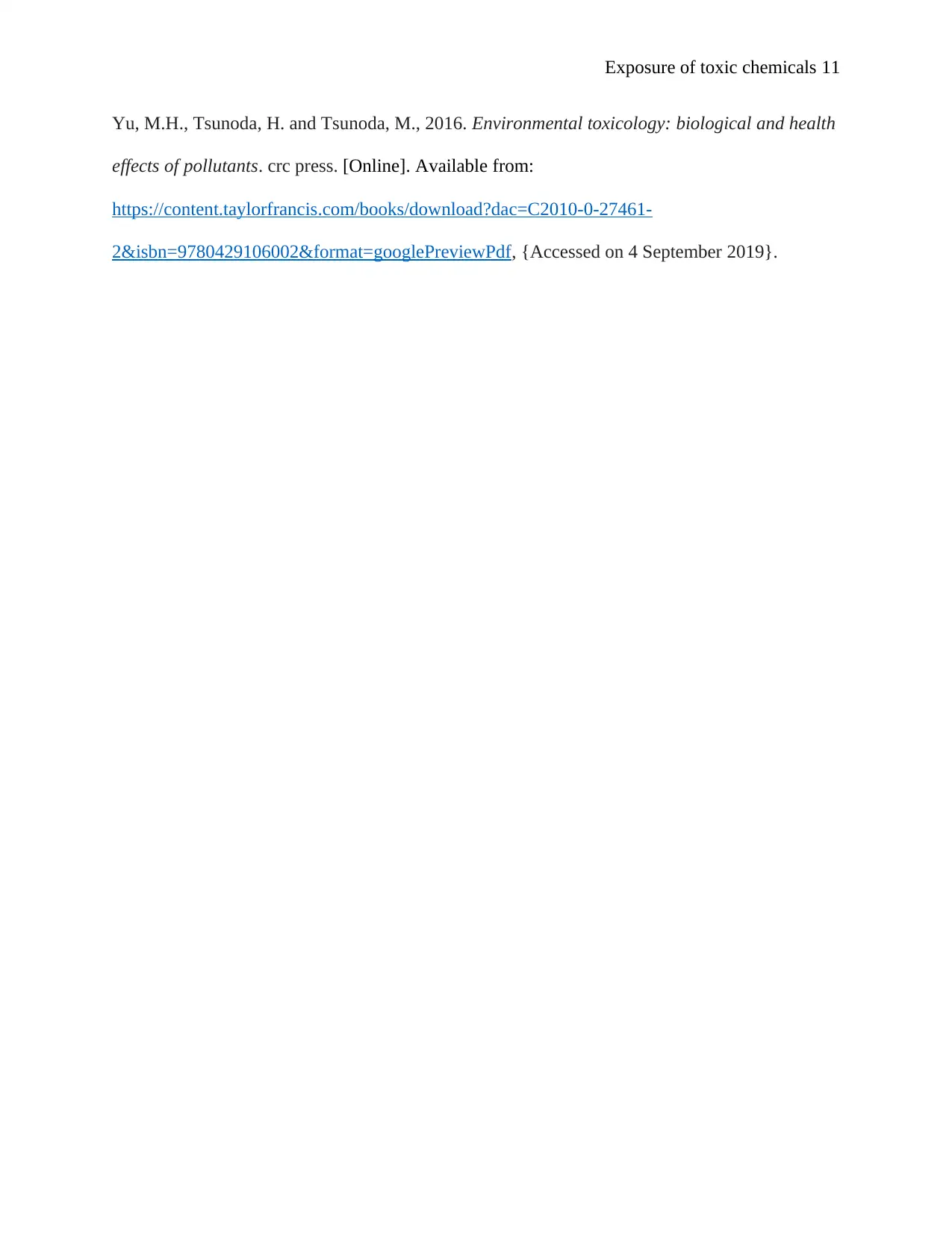
Exposure of toxic chemicals 11
Yu, M.H., Tsunoda, H. and Tsunoda, M., 2016. Environmental toxicology: biological and health
effects of pollutants. crc press. [Online]. Available from:
https://content.taylorfrancis.com/books/download?dac=C2010-0-27461-
2&isbn=9780429106002&format=googlePreviewPdf, {Accessed on 4 September 2019}.
Yu, M.H., Tsunoda, H. and Tsunoda, M., 2016. Environmental toxicology: biological and health
effects of pollutants. crc press. [Online]. Available from:
https://content.taylorfrancis.com/books/download?dac=C2010-0-27461-
2&isbn=9780429106002&format=googlePreviewPdf, {Accessed on 4 September 2019}.
1 out of 11
Related Documents
Your All-in-One AI-Powered Toolkit for Academic Success.
+13062052269
info@desklib.com
Available 24*7 on WhatsApp / Email
![[object Object]](/_next/static/media/star-bottom.7253800d.svg)
Unlock your academic potential
Copyright © 2020–2025 A2Z Services. All Rights Reserved. Developed and managed by ZUCOL.





